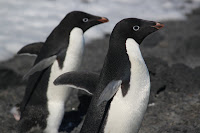
Our helicopter tour of the Dry Valleys region, sea ice and the Cape Royds Adelie penguin colony yesterday was simply out of this world ... I don't know how else to describe it.
Polygons of permafrost, liquid lakes that leak from towering glaciers, stark-white ice emerging from rocky Grand Canyon-like landscapes: this is the Dry Valleys region of Antarctica.

After visiting a research camp at Lake Hoarde in Taylor Valley (visible in the lower left center of the image above), where scientists of all disciplines are coming together to study the unique biology, chemistry and geology of the lake area -- and its similarity to the Mars landscape three million years ago! -- we were off to the edge of the sea ice nearby. Our helicopter needed at least 30 inches of solid ice to land safely, so the helo tech got out first every time we landed in order to measure the ice with a huge corkscrew before any of us could set foot on it. The ice we landed on was about six feet deep, so we were ok. The sea ice growth every austral (Southern Hemisphere) winter around Antarctica is one of the biggest seasonal changes on Earth! Every winter, Antarctica's mass nearly doubles in size due to an increase in sea ice (ice floating on top of the surrounding ocean, without being attached to a glacier).

Shortly after we landed on the ice, about 20 Adelie penguins visited us! This was just a hint of the treat to come later in the day, when we toured the Adelie colony at Cape Royds -- so many penguins! Located on the coast of the Ross Sea, it's the southern-most penguin breeding site in the world. After days of gazing out at frigid, icy landscapes and experiencing Antarctic weather, it was really refreshing to meet real, live animals that don't only survive in this environment, they thrive in it and are really quite content here!

Don't forget to read Dan's Wild Wild Science Journal entries about the trip so far, and check out my Earth Gauge and Capital Weather Gang post about South Pole weather.
Click on the pictures to view the larger versions!


No comments:
Post a Comment